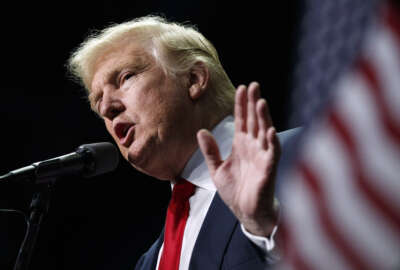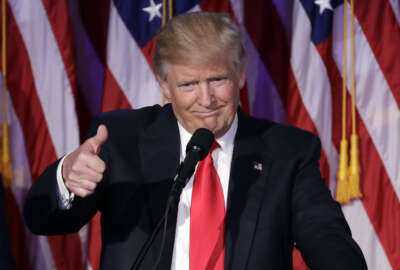

Hubbard Radio Washington DC, LLC. All rights reserved. This website is not intended for users located within the European Economic Area.
President Donald Trump signed a memorandum Monday implementing a federal hiring freeze. It prevents agencies from making most new hires and prevents them from f...
In a move that’s been long promised and widely discussed over the past few months, President Donald Trump signed a memorandum Monday implementing a hiring freeze for some federal employees as a way to eventually trim the overall size of the workforce.
The two-page memo applies to all executive branch agencies, which may not fill any vacant positions that existed as of noon on Jan. 22, 2017, the memo said.
“This memorandum counters the dramatic expansion of the federal workforce in recent years,” White House Press Secretary Sean Spicer said during a Jan. 23 press conference. “In particular, it prevents filling vacant positions and creating new positions except when necessary to meet national or public security responsibilities. It does not apply to military personnel, and it ensures that the American taxpayers get effective and efficient government.”
Yet there are exceptions.
“The head of any executive department or agency may exempt from the hiring freeze any positions that it deems necessary to meet national security or public safety responsibilities. In addition, the director of the Office of Personnel Management may grant exemptions from this freeze where those exemptions are otherwise necessary,” the memo said.
Within 90 days, Office of Management and Budget and OPM must develop a long term plan for reducing the size of the federal workforce through attrition, the memo said. Trump’s Jan. 23 memo will expire once agencies begin to implement OMB’s new plan.
The President originally proposed the idea in October, arguing that a smaller workforce would mean a “more honest and effective government.”
“What the landing teams have been doing is going into these agencies and departments and talking about ways we can create greater efficiencies, eliminate duplicity and maximize the tax dollar,” Spicer said. “It’s more of a question instead of just cutting, it’s about how to spend and respect the American taxpayer dollar going forward.”
Unions and lawmakers have argued that a federal hiring freeze would prevent agencies from delivering mission critical services to the public. They say several years of budget cuts have forced them to cut back already, but Trump wants agencies to get more creative.
“I ask that you seek efficient use of existing personnel and funds to improve public services and the delivery of these services,” Trump said in the memo. “Accordingly, this memorandum does not prohibit making reallocations to meet the highest priority needs and to ensure that essential services are not interrupted and national security is not affected.”
Contrary to Spicer’s characterization, the size of the federal workforce has slowly and steadily declined over the past the 50 years and more dramatically during the past few, when budget cuts and sequestration forced many agencies to cut back.
According to the Office of Personnel Management, 2,038,183 people worked for civilian agencies in 2009. Federal employment ticked up to more than 2.1 million people between 2010 and 2012 but dropped again in 2013, when government employed 2,067,262 people. As of 2015, 2,058,924 people worked for civilian agencies, according to OPM.

According to the National Active and Retired Federal Employees Association, federal employment has dropped 10 percent since 1967.
The memo may impact federal employees across the country, as roughly 85 percent work outside of the Washington metro area.
It does not apply to political appointees that require presidential nomination or Senate confirmation, Schedule C employees in the excepted service or appointees in the non-career Senior Executive Service, the memo said.
Several federal employee unions and associations, as well as lawmakers, have spoken out against the federal hiring freeze.
“President Trump’s action will disrupt government programs and services that benefit everyone and actually increase taxpayer costs by forcing agencies to hire more expensive contractors to do work that civilian government employees are already doing for far less,” J. David Cox, national president of the American Federation of Government Employees, said in a statement.
The National Treasury Employees Union said a federal hiring freeze could lead to “disastrous short-term and long-term impacts.” Budget cuts have already forced agencies to cut personnel, said Tony Reardon, NTEU national president.
“Arbitrary cuts will leave agencies scrambling to serve the public,” he said in a statement. “A hiring freeze takes away the agencies’ ability to make strategic decisions about their workforce.”
More than 100 House Democrats wrote to the President earlier this month, urging him to reconsider his proposal to implement a hiring freeze across the federal workforce.
Yet Rep. Stephen Lynch (D-Mass.) and 106 other lawmakers said a hiring freeze would achieve undesired outcomes for government, citing a 1982 Government Accountability Office study on past federal hiring freezes.
A hiring freeze is not an “effective” way to control federal employment, and it may also exacerbate agencies’ challenges to fill critical skills gaps, attract top talent and achieve their intended missions under tough budgetary constraints, members of Congress said in a Jan. 9 letter.
“A government-wide hiring freeze would exacerbate the serious workforce skills challenges facing a federal government that must continue to address a variety of evolving 21st century issues including cybersecurity, terrorism, consumer safety and environmental threats,” lawmakers wrote.
House Minority Whip Steny Hoyer (D-Md.), who represents thousands of federal employees in Maryland, said he will push for policies that invest in the workforce and make agencies more efficient.
“[It] will do nothing to streamline government operations or reap significant budget savings,” he said. “On the contrary; it will hinder the functioning and efficiency of our government by forcing fewer workers to serve more and more Americans and deterring our best and brightest young people from entering the federal workforce.”
Rep. Gerry Connolly (D-Va.) called the hiring freeze a “mindless way to manage.”
It fails to differentiate critical from non-critical issues,” he said. “It fails to take into account the need to actually beef up certain capabilities in the federal government, like cybersecurity.”
Though she was pleased to hear that the memo does not apply to the military or national security fields, Rep. Barbara Comstock (R-Va.) said based on the impacts of past hiring freezes, she’s worried it won’t deliver the results the new administration thinks it will.
“The federal budget cannot be balanced on the backs of our federal workforce,” she said. “I don’t support this type of across-the-board freeze and think it is better to look at priorities and areas where appropriate cuts can be made and where we can consolidate efforts or identify unnecessary costs that can be eliminated.”
Copyright © 2024 Federal News Network. All rights reserved. This website is not intended for users located within the European Economic Area.
Nicole Ogrysko is a reporter for Federal News Network focusing on the federal workforce and federal pay and benefits.
Follow @nogryskoWFED


